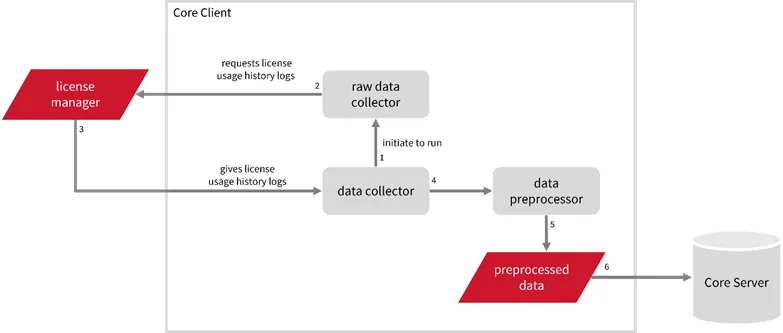Introduction #
Open iT supports ALM usage reporting by collecting log files and converting them to Open iT format.
An Open iT client is installed on your license server, and the license server does not create license usage history logs for this collection. The data collector initiates the raw data collector to request license usage history logs from the license manager every 5 minutes, triggering the data collection process. Once the logs are received, the raw data collector passes them to the data collector. The collected data is then sent to a data preprocessor for processing. After preprocessing, the final preprocessed data is sent and stored in the Core Server.

Log File Parsing Workflow with Raw Collector
This will produce the following aggregated data types used for historical reporting:
Record Log Data:
- (89) Total License Use Licenseevents
- (90) Individual License Use Licenseevents
- (91) Usergroup License Use Licenseevents
- (108) Host License Use Licenseevents
- (109) Hostgroup License Use Licenseevents
Event Log Data:
The following sections will guide you in setting up the necessary configuration to collect and send the required data to the server.
Apply the configurations shown in the Open iT client.
Requirements #
- An Open iT Client connected to an Open iT Server or a coexistent Open iT setup
- License server administrative rights
- Full path to the debug log file
Activating Log Data Collection #
These are the required steps to activate collection of ALM log data.
- Open a command prompt with Administrator level privileges.
- Go to the bin directory, which is by default in C:\Program Files\OpeniT\Core\bin, run the command:
Command Syntax
cd $BIN_DIR
Example
cd C:\Program Files\OpeniT\Core\bin
- Once in the directory, activate the collection of ALM log data, run the command:
Command Syntax
openit_oconfinit -u “collect_license_alm-logs.root.scheduler.jobs.collect_alm_raw_licenselogs.general.active=true”
- Set the path to the database produced by ALM, run the command:
Command Syntax
openit_oconfinit -u “collect_license_alm-logs.root.scheduler.jobs.collect_alm_raw_licenselogs.operations.arguments=automationlm –databasefile \”<database_file>\” –outputfile \”${OpeniT.directories.temp}/SqlCeUtil/ALM/automationlm.csv\” –logdir \”${OpeniT.directories.log}\””
where <database_file> is the path to the database produced by ALM. This is usually in C:\ProgramData\Siemens\Automation\Automation License Manager\logging.
Example
openit_oconfinit -u “collect_license_alm-logs.root.scheduler.jobs.collect_alm_raw_licenselogs.operations.arguments=automationlm –databasefile \”C:\ProgramData\Siemens\Automation\Automation License Manager\logging\almdb.sdf\” –outputfile \”${OpeniT.directories.temp}/SqlCeUtil/ALM/automationlm.csv\” –logdir \”${OpeniT.directories.log}\””
Advanced Configuration #
| Attribute Name | Accepted Value | Description |
| max-instances | Uint (e.g., 5, 8, 9) | The number of instances allowed to run at the same time. |
| max-handling | String (end-oldest, end-all-old, or end-new) | The action done upon reaching the maximum number of instances: end-oldest – Specify this option to stop/kill the oldest instance and start a new one. end-all-old – Specify this option to stop/kill all running instances before starting the new one. end-new – Specify this option to prevent a new instance from starting. |
| end-timeout | Timespan (e.g., P30S, P5M, P1H) | The maximum waiting time before terminating a running instance. |
| quarantine | Timespan (e.g., P30S, P5M, P1H) | The waiting time before starting a new instance after a previous one. |
Configuring Log File Collection #
The ALM log file configuration file, logfilecollector-alm.xml, is found in the Components directory, which is by default in C:\Program Files\OpeniT\Core\Configuration\Components. You don’t need to update this, but if you want to learn more about its behavior, refer to the ALM Log Parser Configuration table.
| Object Name | Accepted Value | Description |
| source.dir | DirName (i.e., ${OpeniT.directories.temp}/SqlCeUtil/ALM/) | Location of the ALM log files. |
| source.pattern | String (i.e., *.csv) | The glob pattern identifying source files in the source directory. |
| source.seen | String (collect, ignore, or tail) | Seen files are the previously collected source files. collect – Specify this option to collect from the start each time. ignore – Specify this option to skip collecting from the same file again. tail – Specify this option to continue collection from the end of the file last time (i.e., collect the ones added since last time). |
| source.cmplines | Integer (e.g., 6, 10, 20) | This is required if the value of source.seen is tail. This is the number of lines compared to source files collected before to determine where to start the collection. Note: If this number is too low, you can end up with an incorrect position, and duplicate data may be in the log files. Usually, it is better to have a few lines more than strictly necessary than even a single line too little. |
| target.dir | DirName (i.e., ${OpeniT.directories.temp}/LogFileCollector) | This is the location of the directory containing the collected log data. |
| target.module | String (i.e., license) | The target type of module (in general). |
| target.datatype | String (i.e., alm) | The specific type of target data. |
| target.interval | Timespan (e.g., P30S, P5M, P1D) | The span of time between collector runs. |
| target.rotation-size | Integer (e.g., 6, 10, 20) | The log file rotates if it goes beyond the number (in mb) defined. |
| target.rotation-glob | String (e.g., *) | The glob pattern to match before the log file rotates. |
ALM Log Parser Configuration
Deactivating Record Log Data Collection #
Turning on log data collection automatically aggregates record and event log data. If you want to collect event log data only, follow these steps.
- Open a command prompt with Administrator level privileges.
- Go to the bin directory, which is by default in C:\Program Files\OpeniT\Core\bin, run the command:
Command Syntax
cd $BIN_DIR
Example
cd C:\Program Files\OpeniT\Core\bin
- Once in the directory, deactivate the collection of record log data, run the command:
Command Syntax
openit_oconfinit -u “collect_license_alm-logs.root.scheduler.jobs.preprocess_alm_licenselogs-records.general.active=false”
- Change the handling of event logs, run the command:
Command Syntax
openit_oconfinit -u “collect_license_alm-logs.root.scheduler.jobs.preprocess_alm_licenselogs-events.operations.arguments=–srcdir \”${OpeniT.directories.temp}/LogFileCollector\” –srcpattern raw-alm-license-LogFileCollector*.data –srcfilehandling rename –trgdir \”${OpeniT.directories.temp}/LogParserALM\” –module license –datatype event –resolution PT1H –matchobjects \”${OpeniT.directories.conf}/matchobjects-event-alm.oconf\” –type event –disable-statlogging”
- Change the data transfer schedule, run the command:
Command Syntax
openit_oconfinit -u “collect_license_alm-logs.root.scheduler.jobs.transfer_alm_licenselogs.scheduling.start-triggers.trigger#1.job-name=preprocess_alm_licenselogs-events”
Verifying Log Data Collection #
After activation, you can verify that the data is collected and sent to the server by following these steps:
- Open a command prompt with Administrator level privileges.
- Go to bin directory, which is by default in C:\Program Files\OpeniT\Core\bin, run the command:
Command Syntax
cd $BIN_DIR
Example
cd C:\Program Files\OpeniT\Core\bin
- Run the command:
Command Syntax
openit_executor -r collect_license_alm-logs
- Verify that there are archiver*.in files created in the server in the archiver directory, which is by default in C:\ProgramData\OpeniT\Data\incoming\archiver.






